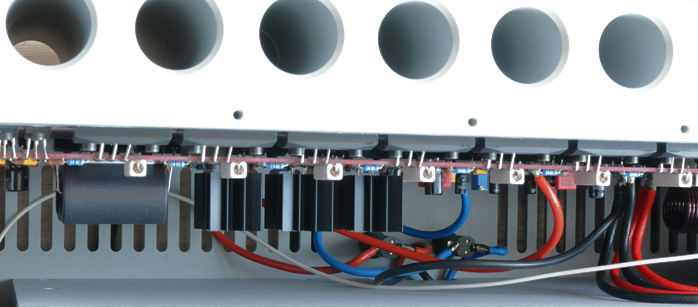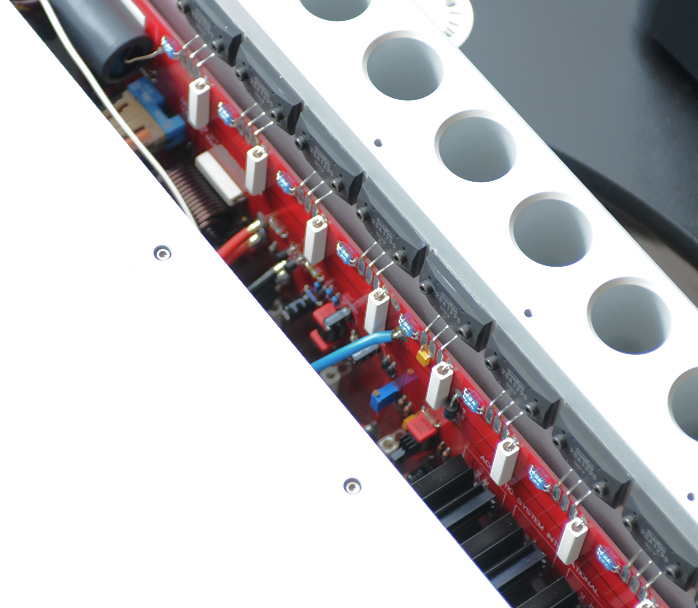 |
With the power amp sitting in place we put the two preamplifier chassis behind it and as a source reached for the PS Audio PWT/PWD combination. In this downstairs listening room our speakers of choice are the Vaessen drop/egg-shaped Aquarius loudspeakers. Interconnects were to be Franck’s ASI LiveLine balanced cables. For loudspeaker cables we used the Japanese Nanotec Golden Strada #79 nano 3. Power was handled by ASI power cables and a Furutech power distributor. Room tuning of course was by ASI resonators and sugar cubes. For the power cable between external power supply and preamplifier, ASI dispatched a custom Cardas cable.
|
 |
|
|
|
|
 |
In the middle of the i/o ports of the preamp sits the 7-pin Cardas power inlet. The separate power supply simply has an IEC inlet, power switch and the matching Cardas 7-pin connector. Over at the Grand Stereo the back shows two balanced inputs flanked by two RCA inputs, two IEC power inlets, two power switches and two pairs of (bi-wired) loudspeaker terminals. Yes, the Grand Stereo is a fully dual mono affair just like the LiveLine preamplifier and its power supply.
|
 |
In an e-mail exchange with Milan he explained how the weight of the amplifier is caused by its two 1600VA toroidal transformers. These are custom made for the ASI Grand series of amplifiers and their main characteristic is very small inductance to be extremely fast and provide a lot of instantaneous current. But there’s more. Each trafo winding has three wires twisted together. This supports speed and current delivery. Separate windings are available for the input section, driver stage, output stage and control electronics. All this rests within a central enclosure of 1cm thick walls shielding the surrounding electronics electrically and acoustically. Speaking of shielding, the specially designed heat sinks are the way they are because this geometry and mass provide the best resonance control in conjunction with the rest of the massive chassis. There’s your backbreaking weight.
|
 |
All Karan power amplifiers are characterized by a continuous sliding bias control. This is unlike the sliding bias used by Krell. Krell raised and lowered bias in predetermined steps like Mayan pyramids. In Karan designs an electronic circuit measures the incoming signal’s amplitude. If there's need for additional output power, the current on the power rails which supply the class A output transistors is raised instantaneously. When the input amplitude goes down again, the bias follows suit. This way the output transistors always obtain the right amount of current and the operational temperature of this hugely powerful class A amplifier remains luke warm even when driven very hard. At 2500V/microsecond this circuit is very fast. Speed is the leading reason why Milan chose Sanken Ring Emitter Transistors. These RETs have far lower rise times than any other type of transistor.
|
 |
|
|
|
|
 |
Working with parts which can handle such speeds without introducing any phase shift between DC and 500kHz means walking a razor’s edge. At these very high speeds—the components are capable of handling signal up to 60MHz—there’s always danger of instability and oscillation. To counter these threats Milan commissioned a lot of custom-made bits like capacitors, resistors and of course wires.
|
 |
We have singled out Milan as the team leader but Karan is actually composed of a team of five. These members are all driven by music and life around music which makes it all worthwhile even though Milan admits that today there’s only music left. They all are getting older and their wild days are over. But the team is still a group of friends. One of them runs a transformer company where he literally ran off hundreds of prototypes until the final quality and performance for this project were reached. Talk about dedication and patience! In-house Karan operates a CNC machine, finishing tools and anodizing equipment. The results of these can be admired in the ASI products.
|
 |
|
 |
  |
 |